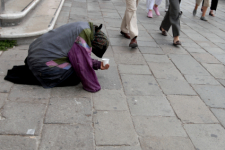Panhandlers Are Usually Not Homeless
/Guest writer was homeless in the Conejo Valley at the time he wrote this (February 2011). He has regained his footing since then and is doing great.
Panhandlers are Usually Not Homeless
Every day that passes, I again wish I was not a member of a growing group of Americans, known as the invisible homeless. Today, as usual, I am presented with a unique, but not totally unexpected set of challenges, which are aggravated by my homelessness. Beginning with my stress level, which is higher than usual today, sometimes resulting in heat flashes. Then continuing on, I’ve been sneezing occasionally, with a frequent runny nose. Those symptoms appear in conjunction with some nagging muscle aches, coupled with a feeling of weakness, both physically and mentally. Does that describe anything that you’ve dealt with?
Living homeless, I’ve also experienced a wide range of weather conditions, specifically wide temperature changes, relentless winds, seasonal circumstances and of course moisture. On those days when I don’t have any work scheduled, “the silence”, which is simply a measure of the mental fatigue and depression, that I live with, is also an unfriendly complaint, exacerbated by my inconsistent sleeping habits. The lack in either physical or mental activity greatly contributes to my depression. Living through these never-ending and ultimately exhausting conditions, day in and day out, I’ve learned that these circumstances continue to have an adverse effect on my overall health.
I’ve concluded that I have a mild cold at the moment, but understanding my homeless living conditions, it’s reasonable to assume my ill health could easily turn into something more serious. I will pay a visit the local drug store, where I may purchase some inexpensive vitamins, and likely a decongestant, which I pray will provide some relief of my more annoying symptoms.
When I’m fortunate to have a commitment during the day, I’m often relieved mentally because these activities stimulate both refreshing thought and often conversation regarding the task at hand. Frankly, any exertion seems to act as a healing agent that relieves the frequent mental fatigue that regularly extinguishes my mind. When I have activities scheduled, I’m also happy to enjoy the feeling of being needed, perhaps wanted, and reminded that there is a so much life outside of my own homelessness, and declining state of health.
Occasionally I’m asked my opinion on whether I would give money directly to the increasing number of homeless on the streets. Perhaps there’s an individual you see regularly, panhandling in your community, presenting a typical card-board sign, asking for food or a donation. Sadly, I answer, “Unless you know the individual personally, you should not give money directly to any homeless person panhandling on the street”. If you’re ever approached by a homeless person and asked for money, I would respond with something like “Sorry, not today”. While I believe everyone deserves respect, my response is based on what I’ve seen most homeless repeatedly do with the money they manage to collect from panhandling. Your donation would be better utilized by a community church or rescue mission, who will likely try and serve all of the poor in your area, who truly need it.
Any homeless person who is panhandling regularly, has in my opinion already accepted their homelessness, likely with little or no plans to turn their life around. “Statistics show that most panhandlers are not homeless, and most homeless do not panhandle. For some, panhandling has become a career, and a lucrative one”, which has been reported from the U.S Department of Justice, Office of Community Oriented Policing Services. In fact, a few savvy panhandlers I’ve seen, boast of making $15 an hour or more during daylight hours on a busy corner, and that money in turn, is typically used to support their destructive habits or dependencies.
I work for the day when I’m no longer a member of the invisible homeless, and have a place to truly rest my head. Perhaps then, I will not resent so much the physical and mental fatigue I often carry around with me.








